By The Sea
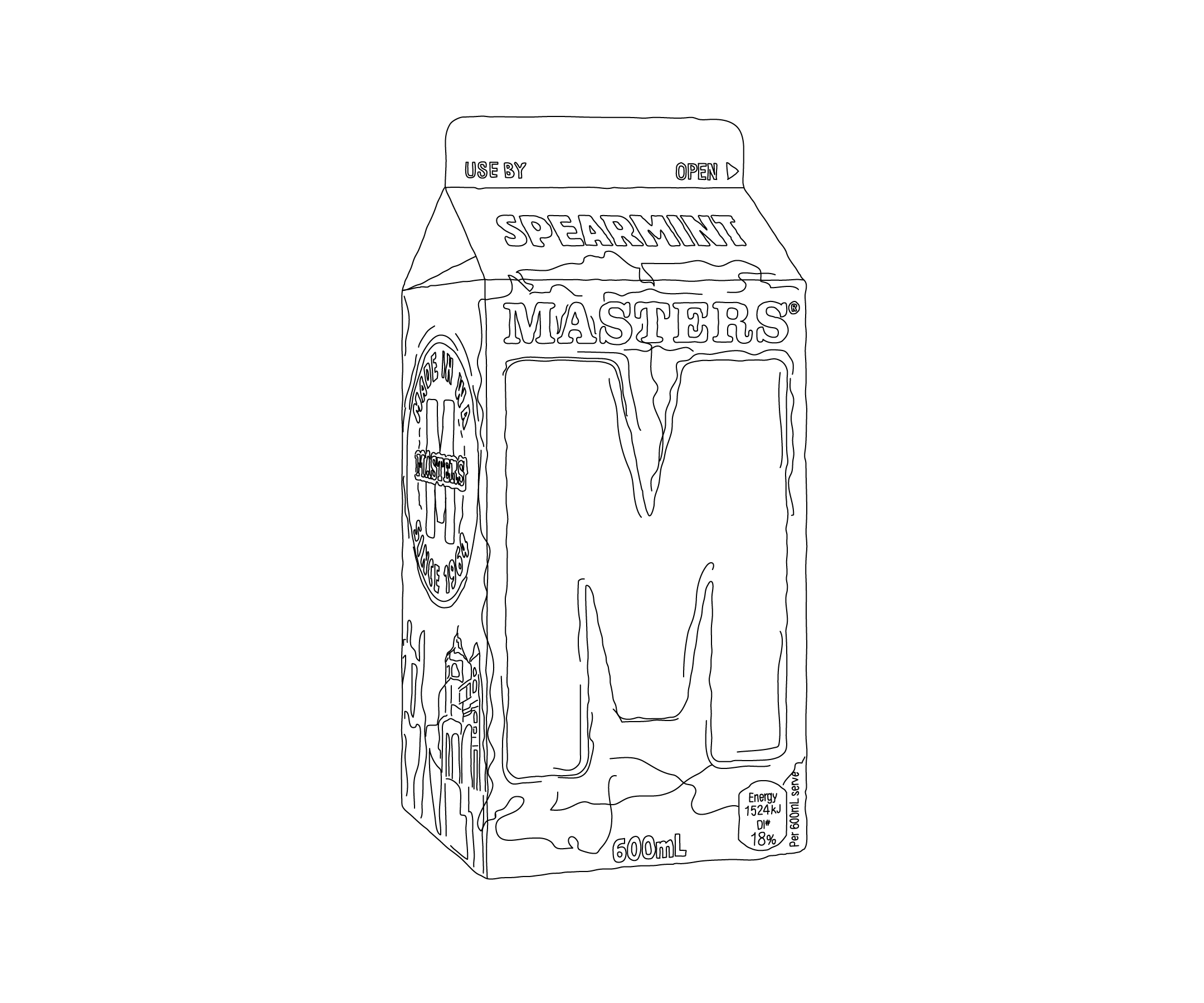
18 March 2020
A response to Sculpture by the sea by Kelly Fliedner
Cottesloe Beach
Everyone in Perth has a favourite beach and Cottesloe Beach is mine. This is much to the bemusement of my father-in-law whose favourite beach is City Beach and who believes City Beach to be the best beach. But I like Cottesloe Beach. I like that the beach itself is small. It takes just the right amount of time to move from the cool grass shaded by tall Norfolk pines, to the hot sand, to the clear water of the ocean. Between the groyne and the Indiana tearooms, the beach is short and sheltered. There is a shark net. It’s cramped and close and I like it. It is intimate. Not like City Beach. City Beach is broad and open and it takes a week to walk from the carpark to the water. City Beach is all horizon and sand dunes. There is no shark net.
It is somewhat of a tragedy that in Perth, a city that thinly sprawls up and down a long beautiful coast, there is no public transit directly connecting its many varied beaches. Cottesloe Beach and City Beach are eight-or-so kilometres—or a 12-minute car-drive—from each other. If you’re bound to public transport however, you’ll need to jump on the 102 to Stirling Highway where you will catch the 998 up past UWA before veering left and switching in Wembley to the 82, which will thankfully and finally deliver you to your destination. There are several other options but all of them will take at least an hour.
*
It is somewhat of a tragedy that in Perth, a city that thinly sprawls up and down a long beautiful coast, there is no public transit directly connecting its many varied beaches. Cottesloe Beach and City Beach are eight-or-so kilometres—or a 12-minute car-drive—from each other. If you’re bound to public transport however, you’ll need to jump on the 102 to Stirling Highway where you will catch the 998 up past UWA before veering left and switching in Wembley to the 82, which will thankfully and finally deliver you to your destination. There are several other options but all of them will take at least an hour.
*
Kate Hulett’s Lost at Sea, a marine ply replica of Perth’s modernist concrete bus shelters, stands testament to this transport oversight on the Cottesloe Beach groyne as part of the 2020 Sculpture by the sea. One side of the shelter faces back in toward the beach, offering a postcard view of the iconic Indiana amid a busy scene of tourists and swimmers and other Sculpture by the sea sculptures. The alternate side faces out toward a much more relaxed Indian Ocean horizon, one still scattered however with a mix of objects, this time freight ships and boats and the occasional kite surfer and stand up paddle boarder.
Uniquely Hulett’s beautiful bus stop sculpture encapsulates two modes of reflection, when almost all other Sculpture by the sea can firmly be found in one or other category. That is, works that lend themselves to the horizon and want to be viewed in relationship to the ocean and all it’s grand and dramatic nature. The second mode are works that focus inward to the culture of the beach and its public. Often in humorous ways, these works celebrate, or at least capture, the kitschiness of the scene and the Sculpture by the sea project in general.
One of these inwardly focused pieces is Public Art by Tanya Lee, a shrunken collection of some of Perth’s most iconic public artworks turned into mini sprinkler versions of themselves. The absurd cartoon-like version of James Angus’ “cactus” or Marcus Canning’s Containbow (2016) look like strange sea creatures or children’s toys and playfully undermine the usual mode of public art—that big and grand is better. They gesture to the great broad lawns of Perth, many of them found in the Western suburbs behind, or to that other most iconic image of Perth, the ubiquitous bore water stain. Size matters but Lee has also brought an otherwise disparate and unconnected group of sculptures together, collapsing space, and just maybe, like Hulett, saying something about the potential connectedness of Perth. It is not only that these sculptures are reduced scale, they are reduced to a kind of unity.
Uniquely Hulett’s beautiful bus stop sculpture encapsulates two modes of reflection, when almost all other Sculpture by the sea can firmly be found in one or other category. That is, works that lend themselves to the horizon and want to be viewed in relationship to the ocean and all it’s grand and dramatic nature. The second mode are works that focus inward to the culture of the beach and its public. Often in humorous ways, these works celebrate, or at least capture, the kitschiness of the scene and the Sculpture by the sea project in general.
One of these inwardly focused pieces is Public Art by Tanya Lee, a shrunken collection of some of Perth’s most iconic public artworks turned into mini sprinkler versions of themselves. The absurd cartoon-like version of James Angus’ “cactus” or Marcus Canning’s Containbow (2016) look like strange sea creatures or children’s toys and playfully undermine the usual mode of public art—that big and grand is better. They gesture to the great broad lawns of Perth, many of them found in the Western suburbs behind, or to that other most iconic image of Perth, the ubiquitous bore water stain. Size matters but Lee has also brought an otherwise disparate and unconnected group of sculptures together, collapsing space, and just maybe, like Hulett, saying something about the potential connectedness of Perth. It is not only that these sculptures are reduced scale, they are reduced to a kind of unity.
[continue reading below︎]


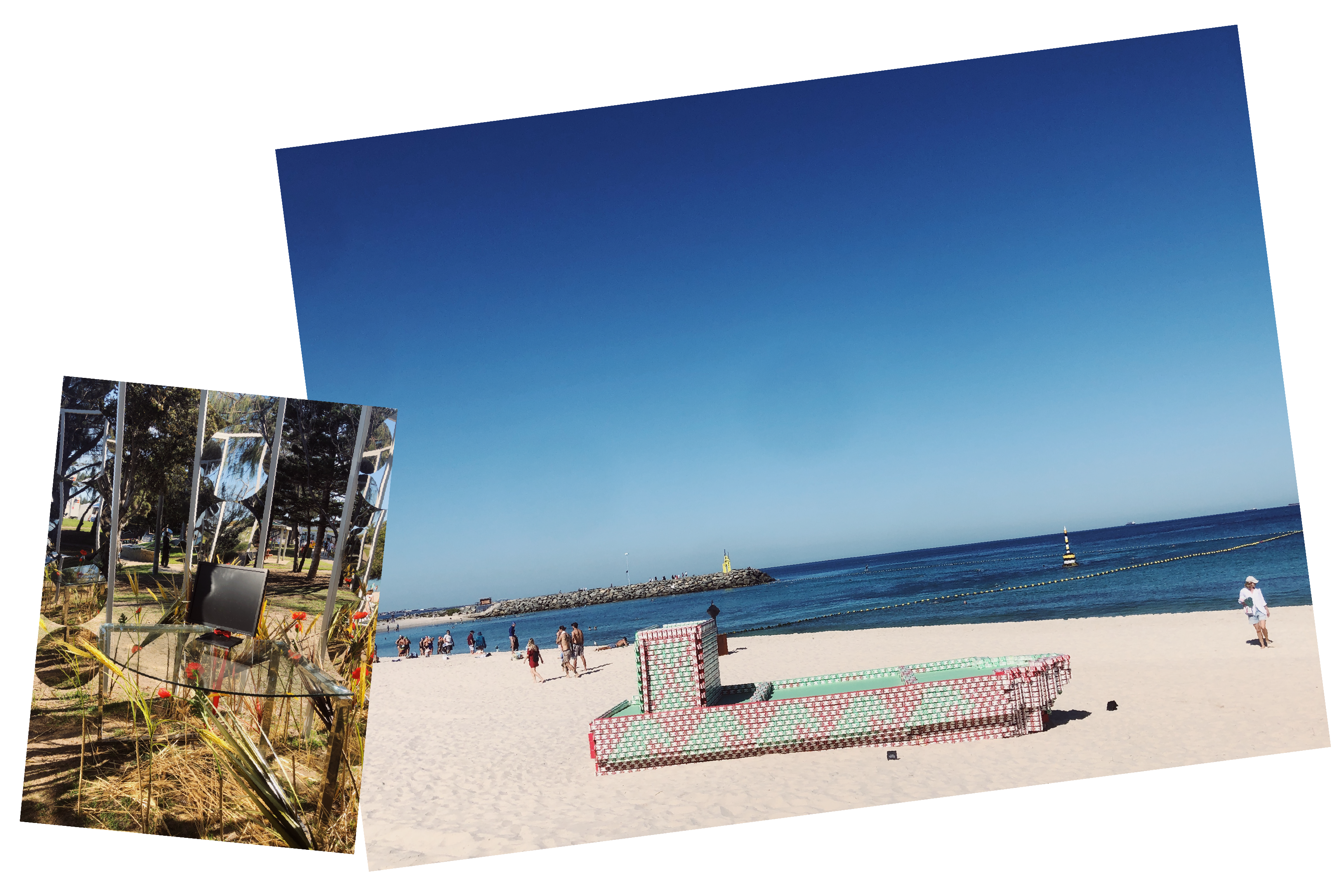
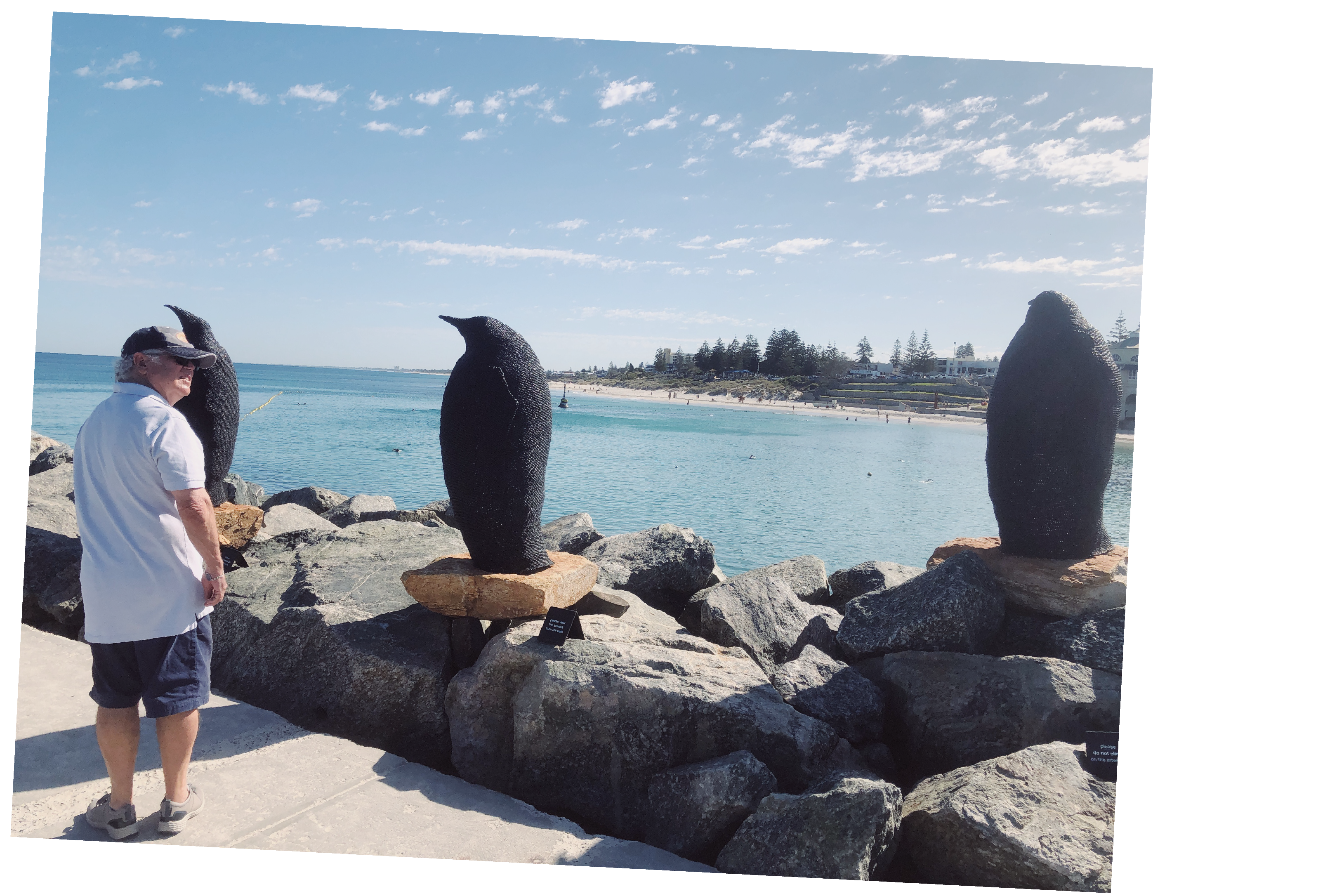
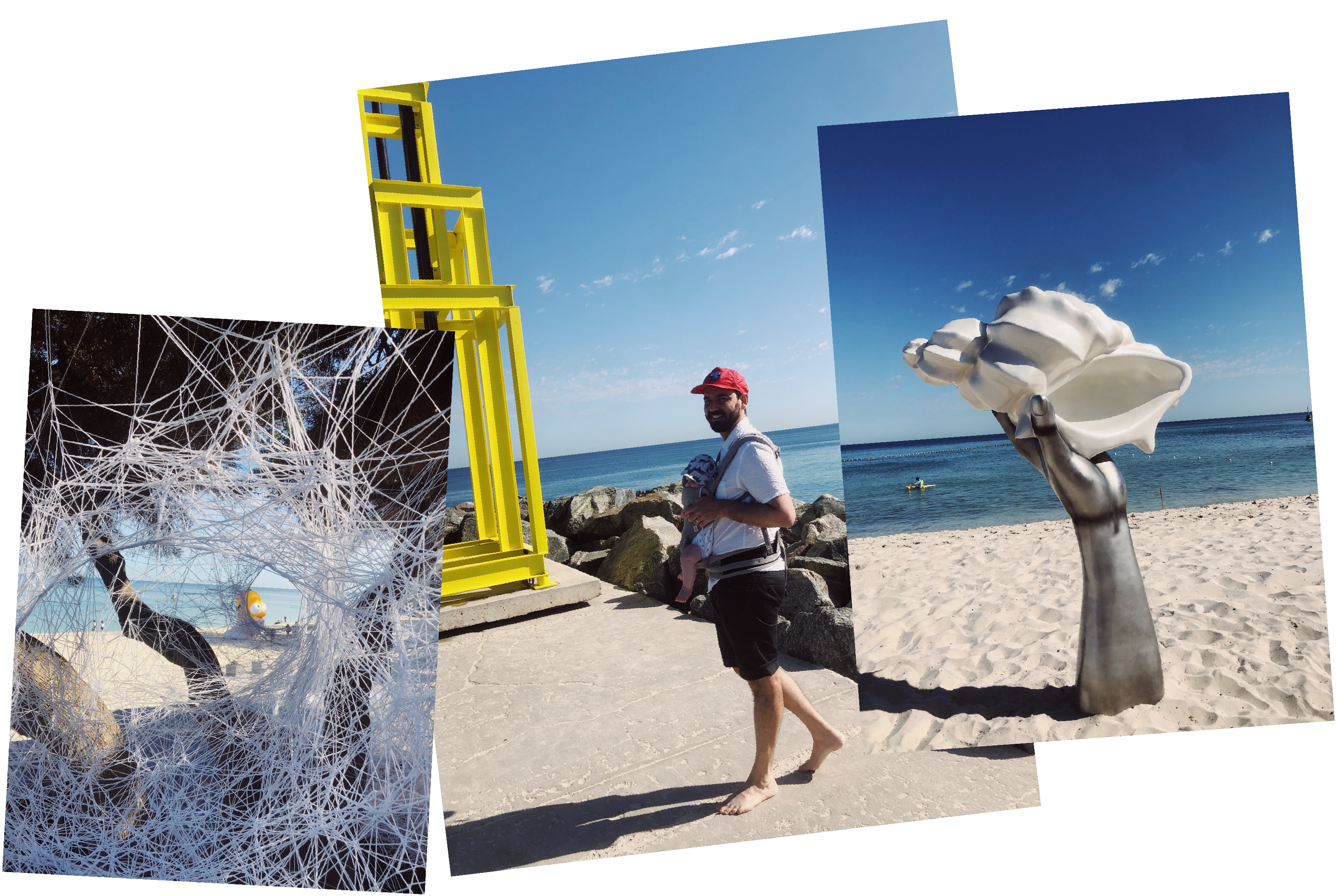


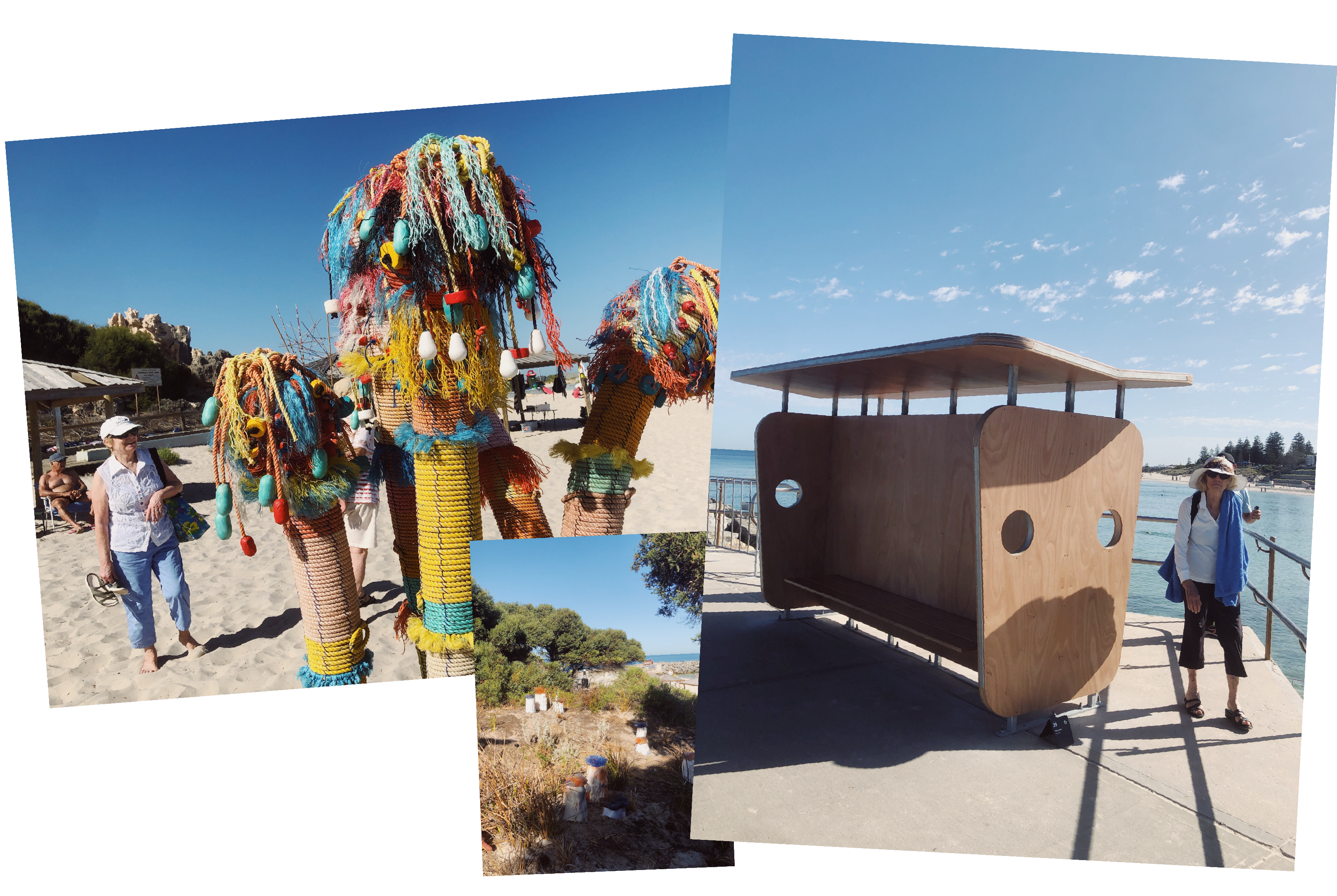
The subjects of Lee’s Public Art and Hulett’s Lost at Sea—public sculptures and bus stops—are already objects in a public space and circulate in a semiotic context that is already open with a specifically Western Australian resonance. The same goes for S.S. Endless Summer by Ellen Broadhurst, Tom Rogers and Jason Waterhouse. This is a very large, albeit very small version, of the many container ships that litter the horizon, making their way to-and-fro the Fremantle port. S.S. Endless Summer is made out of Masters Milk cartons, and features a palette of green, white and brown—chocolate plus the quintessential West Australian spearmint flavour—organised to create a wave motif on the side of the vessel. In its form, it signals a critique of the movement of capital and its impact on the environment. In its name, it references the first feature-length surf documentary, Endless Summer (1966), which follows two surfers as they chase the sun on an epic around-the-world surfing odyssey. It is a saturated nostalgia retrofitted here to recall the locally famous Masters Milk Carton Regattas, particularly salient to those amongst the generation of Broadhurst, Rogers and Waterhouse, whereby Perth residents constructed ships from Masters cardboard milk containers to comically race at Hillarys Boat Harbour north of North Beach.
*
As a whole, Sculpture by the sea is a curious mess of works that reveal the concentrated nature of Cottesloe Beach, which makes for an unsurprisingly unfocused exhibition space. To scatter seventy-ish sculptures in and around the beach creates both a perceived sense of density among the landscape and yet nothing to highlight, somehow both hemmed in and fuzzy. Works assembled so closely together and often in strange unbecoming parts of the foreshore—behind buildings and next to first aid tents—approximate rubbish on the beach.
*
As a whole, Sculpture by the sea is a curious mess of works that reveal the concentrated nature of Cottesloe Beach, which makes for an unsurprisingly unfocused exhibition space. To scatter seventy-ish sculptures in and around the beach creates both a perceived sense of density among the landscape and yet nothing to highlight, somehow both hemmed in and fuzzy. Works assembled so closely together and often in strange unbecoming parts of the foreshore—behind buildings and next to first aid tents—approximate rubbish on the beach.
The works that do worst in this environment are those that seek the vista behind, and demand a clear view. This is only available to a few that appear on the groyne, while all others are left to compete with each other. Many of the works that fall into this category also featured in the 2019 Sculpture by the sea, Bondi: a deconstructed clock face called Elements of Time by Markus Hofer; a yellow and black steel tower called Tower for Jan Palach by Vaclav Fiala, and an assemblage of squares called Between by Danai Kotsaki. Just to name a few. Sydney’s iteration of the project features along a very grand coastal walk with long open cliff faces and natural escarpments. Works in this project become space activations, dramatic and earnest they lend themselves to Instagrams of broad horizons. But here, plonked on this beach, they look awkward. Perhaps like my father-in-law they crave the expanse of City Beach. Something to look at during the week long walk from the car to the shore?
In our last Semaphore Melissa concluded that the beach is about mates. If going to the beach is about your mates then its not about the objects, but about the relations that happen around them. Lee’s Public Art creates a utopic idea of Perth, not as a series of isolated suburbs but as connected and singular. Lost at Sea by Hulett devises a farcical Waiting for Godot-esque scene where public infrastructure that might help to create and connect communities never arrives. WA, Wait Awhile, but enjoy the view while you’re at it. While S.S. Endless Summer gestures towards the memory of a city afloat in a world that is quickly succumbing to both its past and future self. These three works, all made by local artists, look in toward ourselves and understand the charming idiosyncratic clutter and chaos of Cottesloe Beach best... and I want more of that.
In our last Semaphore Melissa concluded that the beach is about mates. If going to the beach is about your mates then its not about the objects, but about the relations that happen around them. Lee’s Public Art creates a utopic idea of Perth, not as a series of isolated suburbs but as connected and singular. Lost at Sea by Hulett devises a farcical Waiting for Godot-esque scene where public infrastructure that might help to create and connect communities never arrives. WA, Wait Awhile, but enjoy the view while you’re at it. While S.S. Endless Summer gestures towards the memory of a city afloat in a world that is quickly succumbing to both its past and future self. These three works, all made by local artists, look in toward ourselves and understand the charming idiosyncratic clutter and chaos of Cottesloe Beach best... and I want more of that.
Sculpture by the Sea, Cottesloe
6 – 23 March 2020
Photos of Sculpture by the sea beach scene and various works by Kelly Fliedner
6 – 23 March 2020
Photos of Sculpture by the sea beach scene and various works by Kelly Fliedner
